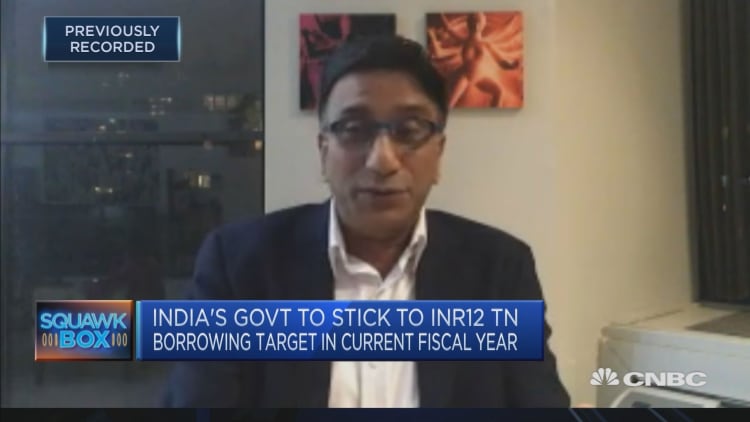SINGAPORE — Economists were not impressed by India's latest economic stimulus aimed at boosting domestic demand by about 730 billion rupees ($9.94 billion) — and some questioned if the new measures can spur long-term growth.
The finance ministry introduced several measures on Monday aimed at spurring consumer spending and bolstering demand in the pandemic-hit economy that saw growth tumble 23.9% between April to June.
"The amount of demand stimulus is underwhelming, and we view the impact on ... growth as quite limited," according to a Nomura note on Monday.
"With the previous rounds of budgetary fiscal support around 1% of GDP, today's demand stimulus measures take total fiscal support (on budget) to about 1.2% of GDP, which is small compared with the size of the growth hit, and reflects India's weak fiscal starting position," said Nomura's chief economist for India and Asia ex-Japan, Sonal Varma, and India economist Aurodeep Nandi.
They explained that the government's reluctance until now to announce the fiscal stimulus was guided by worry that ongoing lockdown restrictions would blunt the effectiveness of those measures in generating more economic output.
I think the government's focus on being obsessed with trying to provide stimulus to the economy to increase demand – we know that is not really going to work.
"Like its previous fiscal measures, the government has continued to prioritise fiscal prudence, and the actual impact on growth is likely to be modest," Varma and Nandi wrote.
Aditi Nayar, principal economist at credit ratings agency ICRA, the Indian affiliate of Moody's, said the new schemes will result in a temporary boost to consumer sentiment and economic activity, "with a sharper pick up in festive season sales that would subsequently fizzle out."
Economists have said New Delhi has little room to increase stimulus without worsening the fiscal deficit. But given the current economic conditions and weak revenue collection, the government's fiscal deficit reportedly remains above its annual target and is expected to stay so for the full year.
The government reportedly said there will be no change in its borrowing program for the current fiscal year even after announcing Monday's stimulus measures. That implies the government may have to cut spending elsewhere to fund the new programs which would ultimately have minimal impact on spurring demand, economists said.
What was announced?
Finance Minister Nirmala Sitharaman said in a statement there were indications "that savings of government and organised sector employees have increased and we want to incentivise such people to boost demand for the benefit of the less fortunate."
The measures include a scheme where central government employees can spend their tax-exempt travel concessions on certain goods and services. Another program allows them to receive a part of their wages in advance to spend on their choice of festival before the end of March next year
Also on Monday New Delhi announced an additional 250 billion rupees ($3.41 billion) for capital expenditure on roads, defense, water supply, urban development and domestically produced capital equipment. It also said it will offer 120 billion rupees of 50-year interest-free loans to state governments for infrastructure spending before the end of the fiscal year on March 31, 2021.
Income support needed
What India needs right now is income support so that when the infection becomes more manageable and restrictions are lifted, consumers and businesses would have the financial stability to borrow and invest, according to Jahangir Aziz, head of emerging markets economics at JPMorgan.

If households, small and medium businesses as well as corporations have damaged balance sheets when the economy opens up fully, then banks are unlikely to lend them money for investments at a time when they need it, he told CNBC's "Squawk Box Asia" on Tuesday.
"I think the government's focus on being obsessed with trying to provide stimulus to the economy to increase demand – we know that is not really going to work," he said. "If you have infection rates going up, if there's social distancing, you really cannot get demand going up."
India is the second worst-affected country in the world, and has more than 7.1 million reported cases of coronavirus infections and over 109,000 fatalities so far.
There are worries that there could be a spike in the coming weeks and months, as the festive season is approaching, and people tend to gather in large crowds at places of worship and at shopping malls.
"You can, (by) providing enough amount of income support, preserve balance sheets. So that when the economy opens up, maybe in the second half of 2021, then we do not have a problem where the economy gets stymied and hamstrung by the fact that banks become risk averse and do not lend to people with damaged balance sheets," Aziz said. He explained that India will likely face a scenario where damaged balance sheets and mounting bad debts will blunt the recovery.
"That's where the government got it wrong. That what you need right now is serious amount of income support and we've known countries who do, who've done that," he added, referring to Brazil as an example.
Economists agree that for the time being, it is likely the Reserve Bank of India has to do the heavy lifting to get growth back on track. But, with inflationary pressures showing up in the economy, the central bank is unlikely to cut rates further until next year, they said.
Last week, the RBI kept its main repo rate unchanged at 4%.


